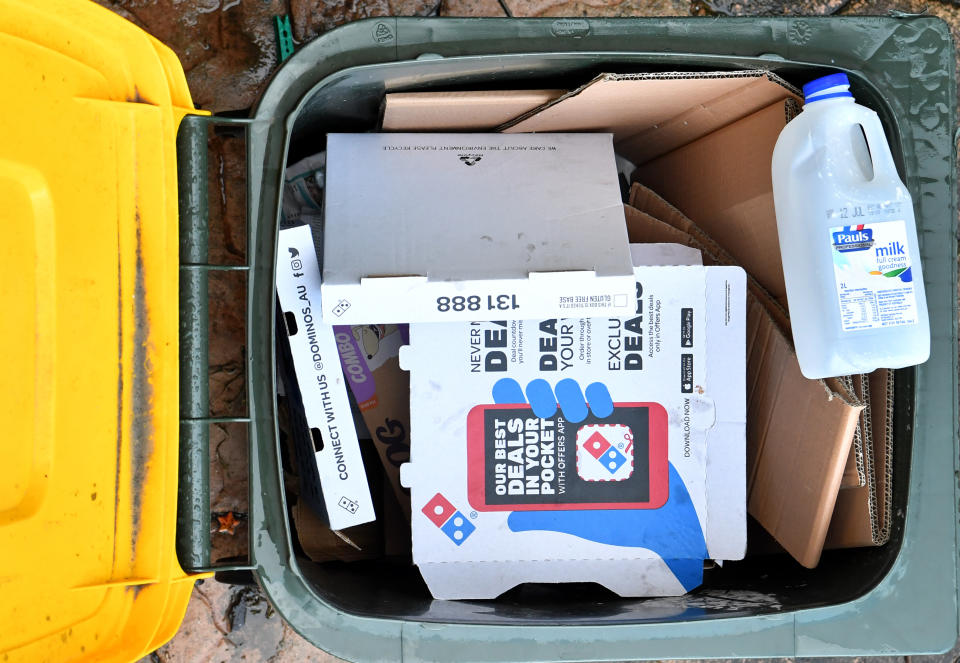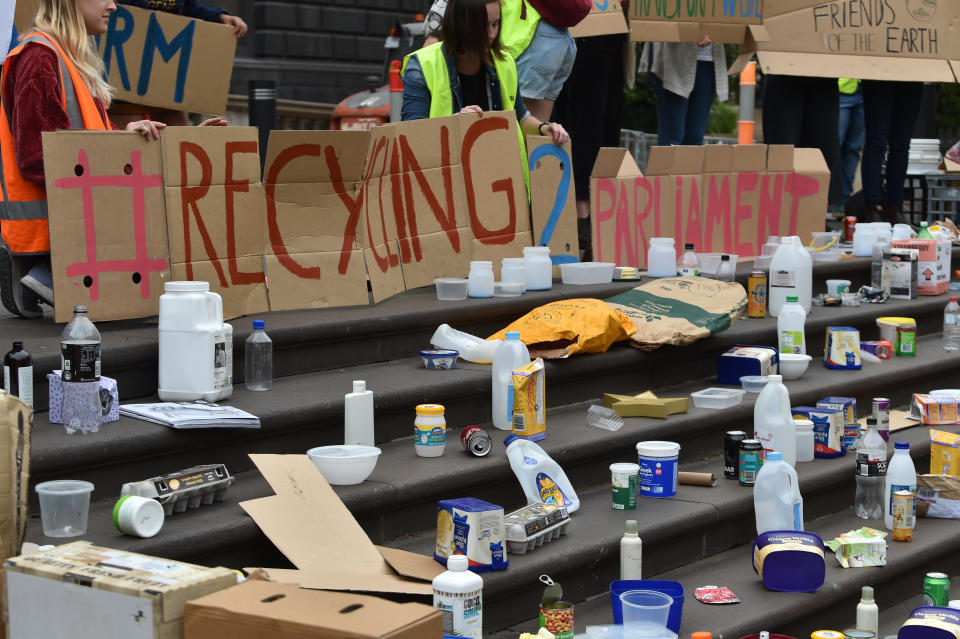The big yellow bin problem: Australia's 'toxic' recycling crisis exposed
Australia is struggling under the weight of the waste we produce, and the items you think you’re recycling are having an increasingly uncertain fate.
Major Victorian recycler SKM warned last week that it is facing liquidation, a prospect it said would cause a landfill crisis in the state and put further pressure on insufficient recycling infrastructure.
It comes after China and other Asian nations that Australia has previously relied on to take our recyclable material shut their doors, leaving states with ever growing stockpiles of rubbish.

Earlier this month, Indonesia sent 210 tonnes of "toxic" garbage back to Australia. The containers of trash we shipped were meant to contain paper for recycling but were mixed with plastic waste and other contaminants inside.
All this adds up to an increasingly uncertain journey for your waste each week when you put the bins on the side of the road.
Recycling increasingly headed for landfill
If SKM goes belly up, the company believes about 400,000 metric tonnes of recyclables will simply be buried in the ground, it told a Victorian Parliamentary Inquiry into waste management.
“It can only finish up in landfill,” says Professor William Clarke from the University of Queensland.
“It might be just that the entire contents of the yellow bin will go into landfill.
“Or it might be that assorted products will go into landfill,” the waste management expert told Yahoo News.
“Certainly a lot of plastic will go into landfill because there’s no customers for it. One of Australia’s main customers for plastic was the Chinese and that market was shut off at the start of the year.”

In 2016-17, nearly 22 million tonnes (Mt) of waste was deposited into landfill, comprising of about 40 per cent of the 54 Mt of core waste generated, according to the government’s National Waste Report 2018.
In recent years the percentage of waste that was ostensibly recycled has inched higher but that trend is in jeopardy as growing stockpiles are destined for a hole in the ground.
The sometimes bizarre business of landfill
Landfill sites are mostly clustered around our capital cities. There are about 600 officially registered sites, and perhaps as many as 2,000 smaller unregulated ones, according to research by Prof Clarke.
“Every jurisdiction agrees that landfill is the least desirable route for waste. The waste hierarchy always requires us to reuse, and recycle before we go to landfill,” he said.
To bolster that incentive, states impose different levies on landfill which can mean your waste might take a rather circuitous journey after leaving your house and reaching its final destination.
Last year rubbish was even dug up from NSW and trucked across the border into Queensland to be put back into the ground, thanks to the perverse financial incentives. However earlier this year the Queensland government moved to end the ridiculous state of affairs by increasing its landfill levy.
“The $70 levy (per tonne) here in Queensland has stopped that transport,” Prof Clarke said. Comparatively, the NSW levy is about $148 a tonne but the added transport costs reduce the likelihood of rubbish being trucked interstate.
Other countries, in Europe for example, place much higher levies on landfill.

‘Of course they’re gonna leak’
Australia has plenty of open space and states like Queensland are full of empty mine-shafts that easily lend themselves to landfill. But there are environmental consequences to the practice in the long run.
“The regulated landfills, the licensed landfills, all have environmental requirements on protecting ground water, air and runoff. That sort of thing,” Prof Clarke said.
The ecological impact of landfill is typically minimal but there is likely a legacy issue, he said.
“They’re there forever. All landfills are lined and capped with at least clay or they might have a polyethylene membrane - but inevitably they will deteriorate.
“They’ll be there in a 100 years… and of course they’re gonna leak,” he said.
“There’s that legacy of potential contamination. There are some components in plastic that could leech over a long period of time.”
However the sad reality is that the cheap, or illegal, alternative is far worse. Last week authorities found 50 million litres of chemical waste illegally buried just metres below the surface on farmland in western Victoria, threatening nearby water supplies.
“In Victoria of course we’ve got all these hazardous waste dumps, rogue operators operating without a license,” Prof Clarke lamented.
The map below shows all the waste management, recycling and reprocessing facilities around the country. It sure looks like a lot, but experts say more investment and infrastructure is needed as Australia has to increasingly deal with its own rubbish.

Converting waste into useable material
Sydney Professor Veena Sahajwalla is a world leader in improving scientific methods and developing systems to reuse and repurpose waste materials.
She leads a team that works to develop world first “microfactories” to take recycled materials put out in council bins, along with other waste streams, and convert them into materials such as metals alloys, plastic filament for 3D printing and glass panels for building products.
“There’s no reason why we should be putting things in to landfill if we can show there is a market for them,” she told Yahoo News Australia.
“The fact that this situation has arisen where countries have stopped taking some of our waste, it has actually allowed some interesting ideas to come to the forefront. Sometimes it does take a good crisis like this.”

‘Green concrete’ made from industrial waste
She points to a world first “green concrete” developed at her University of New South Wales as a type of revolutionary new material that can lead to large-scale waste reduction. The environmentally friendly building product is made using industrial waste from coal-fired power stations.
While the notion of a circular (waste free) economy is still as far fetched idea, she said Australia is a world leader when it comes ingenuity in the space.
“If we’re sitting with access to good quality materials, we could be exporting really fantastic components to somebody somewhere in the world, and that should further support the economic argument” for the investment needed to continually move towards a circular economy, she said.
Do you have a story tip? Email: newsroomau@yahoonews.com.
You can also follow us on Facebook, download the Yahoo News app from iTunes orGoogle Play and stay up to date with the latest news with Yahoo’s daily newsletter. Sign up here.



